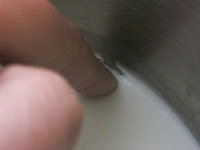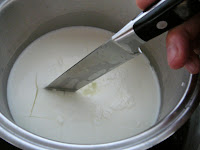So at the end of my brief stay at Tòrrec, not only did Nicanor and his wife, Montserrat, offer me one of their small Matós, they also gave me a bottle of milk with the suggestion I make my own cheese. Now, 1 liter of milk will not make much of anything, but hey - we've all got to start somewhere. So here goes!
1. Preparation
Walk over (still in pajamas) to cheesemake to get thermometer, timer, moulds and rennet.
2. Heating
Pour milk in sauce pan, place milk sauce pan in larger sauce pan filled with water forming a bain marie or double boiler.
Heat water to 37 degrees Celsius...
At this point I stopped heating the water at 34 degrees seeing how quickly the temperature was rising. And at 37 I added the rennet. But the temperature kept rising! Thirty eight... thirty nine... fourty... Oh no! It wasn't stopping! I hadn't accounted for the fact that I was working with a small amount of milk, so the temperature fluctuated rapidly.
The rennet was added and couldn't be taken away. I took the pan out of the water and placed it on an unused burner and the temperature settled at 44 degrees or so. I decided that I would leave the pot open and check the temperature in a few minutes before putting the lid on and hope that the seven-degree rise in temperature wouldn't affect the coagulation of the milk.
3. Waiting
The temperature is back down to 37 degrees Celsius and I've put the lid on the pot and draped a bunch of hand towels over it to try to retain as much of the heat as possible. I thought about placing the milk pot in the water pot again to keep the milk at the proper temperature for longer, but then I don't want the temperature to rise again... Oh! Why don't I adjust the water temperature and then put the milk back in? Yes, let me go see about that...
Ok. It's done, poured some hot water out and some cold water in and I'm at 37 degrees, more or less. I hope the movement of the milk pan into the water pot didn't disturb the coagulation process too much. Will feed myself and check some stuff off my to-do list for the next two hours.
~ 30 minutes later ~
Emboldened by my independent cheesemaking, attempted to make tortilla francés (omelette) as they say in Catalunya. Tried to flip eggs. Result: fail. Must eat eggs scrambled off stove top.
~ 90 minutes later ~
Ten minutes before the two hour wait was up, I checked the water's temperature and found it was at 30 derees Celsius. This was not good. It should have stayed at 37 degrees during the whole coagulation process so I heated some water separately and poured it boiling into my pot, brought the temperature back up to 37 and covered everything with the towels. Maybe I should have raised the water temperature higher to get the milk back up more quickly, but hey - I'll try that next time. Meanwhile the timer rang and I've decided to wait fifteen to twenty minutes longer before putting the knife to the curds. With a lower temperature, the coagulation will probably take longer.
~ 15 minutes later ~
The milk has coagulated! Though the curds appear a little flimsy for my taste, so I've decided to heat some more water to get the milk temperature up again. The curds and whey were a mere 30 degrees Celsius so... here's to waiting a little longer!
~ 15 minutes later ~
4. Cutting
It's time to cut the curds! The Mató recipe could be categorized as a quick/rennet coagulation with a lactic-style ladling into moulds. And Nicanor's personal recipe - the one I'm attempting myself - is quite unique. As he did, I cut the curds with a stainless steel knife in 1-2 inch cubes (though with a vat full of milk, his cubes were about 4 inches wide) so the curds are only sliced east to west and north to south vertically through the mass, not horizontally. Wait an hour more for the whey to come out through the slices.
~ 1 hour later ~
5. Ladling
Excellent. The whey surfaced after an hour's wait or so and I was ready to dig in (gently) and place the curds in my moulds. Scooped everything into one small mould and two and a half faisselle moulds and now the fresh cheeses rest in the sink, draining slowly until tonight when I'll put them on a tray, cover them with saran wrap, and off to the fridge. In the cold they'll drain ever so much more slowly to be ready for savoring tomorrow! (I think) I did it!
To Be Continued...







No comments:
Post a Comment